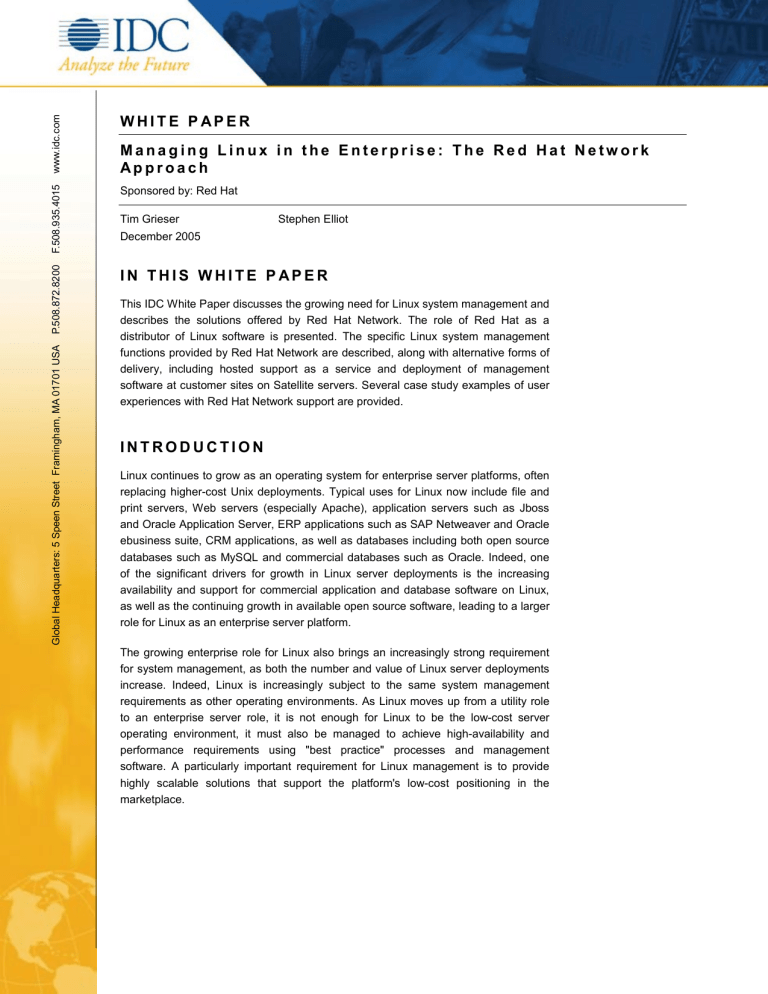WHITE PAPER Managing Linux in the Enterprise: The Red Hat

W H I T E P A P E R
M a n a g i n g L i n u x i n t h e E n t e r p r i s e : T h e R e d H a t N e t w o r k
A p p r o a c h
Sponsored by: Red Hat
Tim Grieser
December 2005
Stephen Elliot
I N T H I S W H I T E P A P E R
This IDC White Paper discusses the growing need for Linux system management and describes the solutions offered by Red Hat Network. The role of Red Hat as a distributor of Linux software is presented. The specific Linux system management functions provided by Red Hat Network are described, along with alternative forms of delivery, including hosted support as a service and deployment of management software at customer sites on Satellite servers. Several case study examples of user experiences with Red Hat Network support are provided.
I N T R O D U C T I O N
Linux continues to grow as an operating system for enterprise server platforms, often replacing higher-cost Unix deployments. Typical uses for Linux now include file and print servers, Web servers (especially Apache), application servers such as Jboss and Oracle Application Server, ERP applications such as SAP Netweaver and Oracle ebusiness suite, CRM applications, as well as databases including both open source databases such as MySQL and commercial databases such as Oracle. Indeed, one of the significant drivers for growth in Linux server deployments is the increasing availability and support for commercial application and database software on Linux, as well as the continuing growth in available open source software, leading to a larger role for Linux as an enterprise server platform.
The growing enterprise role for Linux also brings an increasingly strong requirement for system management, as both the number and value of Linux server deployments increase. Indeed, Linux is increasingly subject to the same system management requirements as other operating environments. As Linux moves up from a utility role to an enterprise server role, it is not enough for Linux to be the low-cost server operating environment, it must also be managed to achieve high-availability and performance requirements using "best practice" processes and management software. A particularly important requirement for Linux management is to provide highly scalable solutions that support the platform's low-cost positioning in the marketplace.
R E D H A T
Red Hat Inc. (Nasdaq: RHAT) is a widely known distributor and supporter of Linux operating system software, based on the open source Linux kernel. Red Hat also provides related software and services, including system management. Red Hat's business model is based on selling subscriptions that provide access to open source technology, as well as support and services. These subscriptions are sold on a persystem basis.
R e d H a t a n d L i n u x
Red Hat (formerly Red Hat Software) has been distributing Linux operating system software in various forms since 1994. Red Hat vigorously supports the open source model, sharing improvements made to the Linux kernel and other open source software with the open source developer community. The idea of Red Hat Linux is to combine open source Linux operating system software, including the Linux kernel, with other software such as compilers, Web servers, email servers, FTP servers, and file servers, to form a bundled distribution. These distributions are combined with Red
Hat maintenance and support services to create a supported Red Hat Enterprise
Linux environment. Red Hat has actively pursued the development of Linux as an application platform and has helped stimulate wider adoption of Linux in large enterprises, working with key system and software vendors as well as the open source community. Today, specific Red Hat Linux editions can support a variety of hardware platforms, including Intel x86 and Itanium, AMD64 / EM64T, Power, and zSeries.
Red Hat Enterprise Linux
Red Hat Enterprise Linux is available in four solution packages: two for servers, one for workstations, and one for clients, as follows.
! Red Hat Enterprise Linux AS for high-end and mission-critical systems
! Red Hat Enterprise Linux ES for small/mid-range servers
! Red Hat Enterprise Linux WS for technical/design workstation clients
! Red Hat Desktop for secure, managed clients
Red Hat Enterprise Linux is intended to be deployed in commercial environments, with the attributes of reliability, scalability, security, and support needed in large-scale, high-value, mission critical IT operations. At the high end, Red Hat Enterprise Linux
AS consists of over 1,500 distinct software packages, and is available with the highest levels of support offered by Red Hat. Typical uses include datacenter servers, mid-tier IT infrastructure, and large departmental deployments.
R e d H a t N e t w o r k
Red Hat Network (RHN) provides system management services for Red Hat technologies and the distributed software that comprise the Red Hat Enterprise Linux operating system, as well as for applications deployed on Red Hat Enterprise Linux.
Red Hat Network began production operations in 2000 as a hosted service designed to provide direct support to individual users and small businesses over the Internet.
As deployment of Red Hat Linux spread to larger organizations, including enterprises, additional Red Hat Network support has been added, including options for Proxy and
Satellite servers located at customer sites. Currently, Red Hat Network supports
Hosted, Proxy server, and Satellite server options, which are available to users through specific subscription licensing terms.
Addressing Linux Service Provisioning
Red Hat Network is strategic to Red Hat's business and revenue generation; Linux system management is an area that leading edge enterprises will have to invest in to deliver high-quality, available services. The company continues to invest in Red Hat
Network; the recent expansion into Solaris systems management brings multiplatform capabilities that customers are asking for. Customers should expect continued market development and technology investment into the Red Hat Network.
Solving Linux Management Issues
Red Hat Network solves a multitude of Linux management problems that impact the availability, performance, and successful delivery of Linux-based business services.
Customers choose Red Hat Network to deliver critical system management facilities, including provisioning a Linux-based system, patch management, OS deployment, and enabling the deployment of fully configured systems based on its defined function. While these critical problems are solved, there are additional system management issues that IDC has discussed with customers, including monitoring system performance, redeploying existing systems, and maintaining a steady state of inventory information and system consistency for lower cost operations and increased control.
R e d H a t N e t w o r k : S e r v i c e s a n d M o d u l e s
Red Hat Network functions are delivered in the form of service modules sold as subscriptions, on a per-system basis.
! Update module.
Update is the entry-level Red Hat Network service module that is included as part of an Enterprise Linux subscription. Update provides a graphical user interface for ease of operation. The update module provides facilities for performing software installation and updates to individual systems, including applying security and functional patches. Update processes a content stream from Red Hat and supports notification, dependency checking through the
Red Hat Package Manager (RPM), and auto update. Update can also be used to remove undesired packages from servers.
©2005 IDC #IDCUS05WP002149 3
! Management module.
The Red Hat Network Management module supports enterprise administration of the Linux infrastructure. It features system grouping facilities for "scaling out" of management tasks, role-based administration for policies and permissions, scheduling of actions for specific time windows (such as updates) and support for additional functions for Satellite servers.
! Provisioning module.
Provisioning provides facilities for Linux operating system provisioning on "bare metal" systems and reprovisioning Linux on previously deployed systems. The Provisioning module also supports application provisioning based on the Red Hat Package Manager (RPM). It provides facilities for configuration management, system migration, snapshotting, and rollback to previous configurations. It can also write configuration settings for "kick start," a rapid deployment facility.
! Monitoring module.
Monitoring is a new Red Hat Network facility that tracks system and application metrics, such as processor, memory, and disk utilization; compares them to thresholds; and generates alerts for exceptional conditions.
Monitoring is designed to support performance management by tracking system performance, recording event histories, and providing reports and graphs of historical data that can be used to make informed resource allocation and capacity assessment decisions.
R e d H a t N e t w o r k : D e p l o y m e n t O p t i o n s
Hosted Service
The basic Red Hat Network offering is delivered as a hosted subscription service, provided by Red Hat. Individual customer systems connect to the Red Hat Network operations center over the Internet and obtain software distributions, updates, and related management information from central Red Hat Network servers. As shown in
Figure 1, this MSP-type architecture features remote management services and support located at Red Hat with the managed systems located at the customer's site.
This is an effective service delivery mechanism for individual users and small groups of servers, but it is not highly scalable due to architectural and bandwidth limitations.
F I G U R E 1
H o s t e d R e d H a t N e t w o r k
Source: Red Hat, 2005
Satellite Server
The Satellite server deployment option provides all Red Hat Network functions stored locally on a server connected to the customer's network. The local Satellite server connects with RHN central to download updates over the Internet, and store them on the Satellite for local distribution. The Satellite server contains an embedded database that scales to support thousands of connected systems. The Satellite server supports advanced functionality, including monitoring and Solaris management. The
Satellite server can also be run disconnected from the Internet to provide more secure operations. The Red Hat Network satellite server architecture is shown in
Figure 2.
©2005 IDC #IDCUS05WP002149 5
F I G U R E 2
S a t e l l i t e S e r v e r A r c h i t e c t u r e
Source: Red Hat, 2005
Proxy Server
Red Hat Network offers a Proxy server option where an RHN Proxy is deployed on the customer's network. The Proxy provides secure local caching of Red Hat Network content, thereby increasing scalability. Proxy server can be used with either the
Hosted or Satellite deployment models. In a Hosted deployment, it reduces Internet bandwidth consumption. When paired with Satellite, it improves scalability, especially when managed systems are in several geographic locations.
C A S E S T U D I E S
V a n d e r b i l t U n i v e r s i t y
Vanderbilt University, located in Nashville, Tennessee, is a private educational institution with over 10,000 undergraduate and graduate students, and over 3,500 fulland part-time faculty members. In recent years, Linux has played an increasingly important role in Vanderbilt's IT infrastructure.
Business and Technology Overview
About two years ago, Vanderbilt University conducted a business analysis to consolidate hardware to streamline costs, maximize platform utilization, and decide if a move to a Linux-based architecture would meet business and technology requirements. After analyzing operations costs and existing processes, Vanderbilt 's
IT organizations decided to move from HP-UX hardware to Linux-based servers to run their Web-based applications and clustered Oracle databases. With mission critical applications migrated onto the Linux systems, downtime had to be minimized and proactively managed. Prior to the migration, the IT organization made infrastructure management a core component of the consolidation project and budgeted resources toward developing best practices and streamlined processes for the new Linux environment. Before the Linux system was implemented, the IT organization experienced pain points involving server patch management, configuration updates, server monitoring, and new server roll-outs. There was a general lack of documented processes and staff were reacting to error reports, poor performance, and reduced quality of service. The staff was struggling with managing test, development, and operations server groups with disjointed update and patch cycles that were not documented . With the migration to Linux, the IT organization realized that a better, more efficient change management solution was necessary to maximize the staff's expertise and increase the quality of service.
Solution Value
As a solution, Vanderbilt decided on adopting the Red Hat Network Satellite server to streamline the patch management processes and manage the configurations of its
Enterprise Linux-based server installation. The executive team and system administrators replaced the previously manual task of patch management processes that utilized kick-start files and custom scripts by using the automated Red Hat
Network functionality that pushes out configurations and patches to the Linux systems in a scheduled, controlled manner. The Satellite server enables IT to own and customize all the functionality required, such as errata cloning, bare metal provisioning, and channel cloning onsite and receive updates over the public network.
Vanderbilt can execute patch management and server provisioning tasks when required. The local database repository empowers Vanderbilt's system administrators to deliver reports and control detailed configuration, patch, and group provisioning tasks. The Satellite implementation went smoothly; with additional value coming from the ability of the IT organization to maintain its headcount and streamline server responsibilities and processes that have improved the quality of Linux-based services. With the initial consolidation project completed, the IT organization is
©2005 IDC #IDCUS05WP002149 7
planning for the future that likely includes an integration of the Satellite server into the service desk ticketing system and legacy system management solutions. An expansion of the Web-based reporting is being considered as IT delivers more information to different technology groups from the Satellite server.
People, Process, and Technology Impact
With the Satellite server implementation complete, Vanderbilt has experienced several improvements in technology, staffing, and processes. From a technology perspective, the University has established Red Hat Network as the standard for
Linux-based system management allowing IT to centralize and control patch management and configuration inventory for a more secure and efficient infrastructure less prone to human errors. From a staffing perspective, the IT organizations has been able to manage more servers with the same amount of IT staff, minimizing headcount costs and reducing the amount of time system administrators used to spend finding and fixing configurations and failed patch jobs.
Finally, critical processes that enable efficient application delivery and server provisioning have experienced reduced downtime and improved visibility. Patch management, configuration processes, and server rollouts are streamlined with standardized and documented processes that have the IT team a step ahead of server demand and configuration problems. The IT organization now has the capability to push out, in real time, new patches and configuration fixes that are installed as a defined, managed task. The ability to streamline people, processes, and technology for Vanderbilt's IT organization enables the efficient, quality delivery of services.
Future Developments
Future developments for Vanderbilt include the extension of Red Hat Network into
Linux monitoring for performance problems that arise in the Linux platform. More integration with service desk and legacy system management products is planned, as the University continues to improve processes for delivering high-quality service to its growing base of customers. Red Hat support has been solid. Answers have been clear and articulated well, with phone calls and email requests answered in a reasonable time period.
M a r s h a l l S p a c e F l i g h t C e n t e r ' s ( M S F C )
M i s s i o n O p e r a t i o n s L a b o r a t o r y
Business and Technology Overview
About two and a half years ago, the Marshall Space Flight Center's Mission
Operations Laboratory (part of National Aeronautics Space Administration)IT organization was looking to improve their mission-critical processes of getting space station data to scientists who make important, often ground-breaking decisions. A second goal for the system administration team was to improve the processes and procedures for patch management and software configurations on flight system servers. At this time, the IT organization was making the decision to move to a hardware platform that supported Linux. The key drivers of the decision and the
allocation of resources toward Linux management were cost containment and reduction, and improved server utilization. IT assembled the business case for Linux management and made the decision, based on costs and functional requirements, to buy a product instead of writing and managing custom code. MSFC's Mission
Operations Laboratory's IT department purchased a Red Hat Network Satellite server with several Proxy servers.
Solution Value
The Red Hat Network Satellite system with Proxy servers was implemented to push out OS updates, conduct multistate rollbacks, and verify and correct patch status. At the end of each month, MSFC's Mission Operations Laboratory's IT organization applies over 840 updates a month to 240 systems. The ability to successfully manage patches, software OS updates, and configurations is enabled through Red Hat
Network. The Satellite and Proxy servers enable secure connectivity for MSFC's
Mission Operations Laboratory to get downloads and have an API interface layer for integration into legacy system management products. The Red Hat implementation improves server utilization and CPU performance through increased visibility into management data and better resource management. The Web interface to the
Satellite server is used daily to analyze data and generate reports to identify and resolve potential trouble spots for patch management and OS deployment problems.
People, Process, and Technology Impact
The implementation of the Red Hat Network Satellite Server has been considered a success for multiple reasons, notably for its ability to improve operational and cost efficiencies for the Linux platform and the reduction in script generation for patch and
OS deployment. IT staff have more time to work on strategic projects and spend considerably less time writing and managing custom code for updating systems and scheduling patches. The Satellite server automatically receives updates from Red Hat and corrects any Linux infrastructure inconsistencies when necessary. The automation of various processes involving both IT staff and Red Hat technology has led MSFC's Mission Operations Laboratory's IT organization to plan for a future reduction in the number of Linux servers under management due to better visibility of server utilization.
Future Developments
The Red Hat Network service has empowered the IT organization to improve their service levels and Linux server utilization, and develop more accurate and consistent patch and OS workflows. Using Red Hat Network assures MSFC's Mission
Operations Laboratory that secure updates are tracked, recorded, and can be applied automatically and in real time, if desired, saving valuable labor costs and improving the quality of life for system administrators. The IT organization has future plans to integrate existing system management tools via APIs, and hopes to begin to track service-level metrics as they relate to the mission-critical, Linux-based applications that drive space exploration.
©2005 IDC #IDCUS05WP002149 9
C H A L L E N G E S / O P P O R T U N I T I E S
Red Hat has succeeded in establishing a positive reputation, both for the Red Hat
Enterprise Linux operating system itself and for the Red Hat Network system management service offerings. Indeed, Red Hat has been one of the major influencers in building Linux acceptance as a major platform in the enterprise.
One of the major challenges facing Red Hat is to continue to maintain the momentum behind the further development and spread of Linux, while at the same time building the Red Hat business, especially given the fact that there are competing alternatives for commercial Linux distributions and support. As Linux gains in acceptance and importance, major system and software players will take an increasing interest. This will present Red Hat with increasing challenges in forming and developing partnerships with key vendors, both in hardware and in applications and system management software, which are essential to future success. The strong integration between Enterprise Linux and Red Hat Network will likely play a key role for Red Hat in providing value as competition in the space continues to grow. Also, Red Hat must continue to maintain the balance between its commercial activities and its strong commitment and positioning as an open source supporter.
S U M M A R Y A N D C O N C L U S I O N
Growth of Linux adoption by enterprise IT requires and depends on strong support, similar to what is customary and expected for commercial operating system environments such as Unix and Windows. Red Hat provides a valuable service by taking open source Linux software and providing commercial-grade distribution and support.
The Red Hat Network approach to Linux system management and support provides strong options for individual users, small businesses, departmental servers, and enterprises that are using the Red Hat Enterprise Linux operating system. The case studies presented in this White Paper reveal a number of positive benefits and experiences with Red Hat Network, based on user experiences.
C o p y r i g h t N o t i c e
External Publication of IDC Information and Data — Any IDC information that is to be used in advertising, press releases, or promotional materials requires prior written approval from the appropriate IDC Vice President or Country Manager. A draft of the proposed document should accompany any such request. IDC reserves the right to deny approval of external usage for any reason.
Copyright 2005 IDC. Reproduction without written permission is completely forbidden.








